Lord Muck's Blog
September 30, 2020
I have mentioned before (Myths, stories and adventures in the Irish ‘Sky Garden’ 27 June 2019) that the Hegarty side of the Muck family hail from Skibbereen in Co Cork. Skibbereen was a centre of the Great Famine of 1845-50. There is a very moving exhibition on the impact of the famine in the Heritage Centre on Upper Bridge Street, and a famine trail round the town which ends up at the Abbeystrewery Cemetery where an estimated 8-10,000 victims are buried in pits.  Almost one third of the 100,00 population of the Skibbereen area lost their lives during those terrible years, with many more forced to emigrate, and the town became synonymous with the suffering of people across Ireland after it was widely publicised in the famous stark drawings of James Mahoney for the Illustrated London News.
Almost one third of the 100,00 population of the Skibbereen area lost their lives during those terrible years, with many more forced to emigrate, and the town became synonymous with the suffering of people across Ireland after it was widely publicised in the famous stark drawings of James Mahoney for the Illustrated London News.  The cause of the famine in the first place was an over-reliance on a single variety of potato by an extraordinarily impoverished populace. When it got blight and the potatoes rotted in the ground there was nothing to fall back on, and the British state was completely unprepared for, and then unwilling to act to relieve, a famine in its own country (Ireland was then part of Great Britain and Ireland, post the 1801 Act of Union).
The cause of the famine in the first place was an over-reliance on a single variety of potato by an extraordinarily impoverished populace. When it got blight and the potatoes rotted in the ground there was nothing to fall back on, and the British state was completely unprepared for, and then unwilling to act to relieve, a famine in its own country (Ireland was then part of Great Britain and Ireland, post the 1801 Act of Union).
But the Hegarty’s survived. How? Well the answer is perhaps counter-intuitively, the potato. The family story is that during the Famine people around Skibbereen were banned from planting potatoes from their own seed because it would be blighted stock and would itself fail, while spreading the spores to other potato crops. But Michael Hegarty (b c1805) hid a sackful in a shed,  and then planted them in a field in a very isolated valley out beyond Castlehaven. News got out of this illegal stash, and he was instructed to reveal the location of the field where these potatoes were. But by that time they were up and thriving, never caught the blight, and went on to produce an excellent crop; a crop which saw the family through the famine.
and then planted them in a field in a very isolated valley out beyond Castlehaven. News got out of this illegal stash, and he was instructed to reveal the location of the field where these potatoes were. But by that time they were up and thriving, never caught the blight, and went on to produce an excellent crop; a crop which saw the family through the famine.
I remember this story every autumn when bringing in my own (unblighted) crop – which of course is nowhere near the staple food that it was to my ancestors.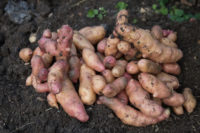 But it is a reminder of the narrow path we tread between feast and famine, one which in this year of an excellent harvest, is all the more powerful for being at a time of global sadness and death from another invisible airborne grim reaper.
But it is a reminder of the narrow path we tread between feast and famine, one which in this year of an excellent harvest, is all the more powerful for being at a time of global sadness and death from another invisible airborne grim reaper.
August 19, 2020
Lockdown has its compensations, and one of them has been a dramatic increase in the amount I listen to BBC Radio 3. There are many excellent presenters, including Sarah Walker, Ian Skelly, Hannah French, Kate Mollison, Sara Mohr-Pietch and best of all, her fellow presenter on ‘Night Tracks’, Hannah Peel. Their show runs from 11 pm, crossing the boundary between one day and the next. Not untypical of Peel’s selections will be a collaboration between some traditional Welsh performers and instrumentalists from Mali.
Last night she hosted a special immersive sound track devoted to the music of plants in a show entitled ‘Midnight in the Garden’, and what magic it was.
From evocations of gardens and growing, to music played on vegetables by the The Vegetable Orchestra, or created by spider plants, it was all there; Puccini to Radiohead, JS Bach to David Bowie, experimental electronic paens to the plant world with Stevie Wonder’s ‘Journey through the secret life of plants’ and electronic pioneer Mort Garson’s ‘Mother Earth’s phantasia’. But it was the plants themselves that stole the show. Listening in on the biochemistry of a singing snake plant, or delving into the sounds beneath the bark of a horse chestnut tree in Alex Metcalf’s ‘Horse chestnut’, is surely the way to be transported to another world as the darkness enfolds us, the sounds of the day hush, and the magic of the starlit universe creeps up on our consciousness.
‘Midnight in the Garden’ is available on BBC Sounds until 17 September 2020.
July 8, 2020
It is twenty two years since I carried a large stick-like object up to my new allotment orchard and planted it. It was a walnut tree. Now it dominates the corner of the plot and indeed the site as a whole, towering over the other fruit trees and the hedge that separates the site from the road. In retrospect I’m relieved that I realised that planting it in a corner where as it grew, it wouldn’t come to dominate the entire plot, was the sensible thing to do, because it is large, and I suspect has many more years of growth in it. My orchard has many trees – apples (cooking and eating), pears, plums, greengages, cherry and cobnut, but none are going to grow to this size, being grown on rootstock that ensures they remain of ‘pickable’ size.
As it has grown I have often wondered when I would see a walnut on it, and indeed for about a decade there has been a smattering of nuts, perhaps a dozen or so in any year, distributed across a tree so large that it has been hard to discern them amongst the foliage, let alone find any within picking distance. So this year has been something of a revelation. Finally … a serious crop; the right combination of weather conditions presumably. Taking a look at it at the end of June suggested that there might be 5-600 nuts. And walnuts really do come in as my favourite nut. But there is another walnut tree on the site – older and more mature and occasionally laden with nuts. So much so that the branches are weighed down and gracefully brush the roofs of plotholders sheds. Until early September. Then the squirrels get to work – and boy do they work. An entire tree completely stripped of unripe nuts in the space of 3-4 days. Hundreds if not thousands of nuts ruined some years. Inedible to squirrels and to humans alike.
the right combination of weather conditions presumably. Taking a look at it at the end of June suggested that there might be 5-600 nuts. And walnuts really do come in as my favourite nut. But there is another walnut tree on the site – older and more mature and occasionally laden with nuts. So much so that the branches are weighed down and gracefully brush the roofs of plotholders sheds. Until early September. Then the squirrels get to work – and boy do they work. An entire tree completely stripped of unripe nuts in the space of 3-4 days. Hundreds if not thousands of nuts ruined some years. Inedible to squirrels and to humans alike.
My old friend from CND days Dave Barbour has a huge grove of walnut trees on his farm outside Chipping Norton and every autumn comes into the farmer’s market to sell them and the walnut oil he presses. Fantastic quality, and to my eyes, fantastic quantity. How does he manage it I wonder?
Me, ‘Don’t you have a problem with squirrels?’
‘Yes’ he replies, ‘we do have a problem with squirrels.’
‘How do you solve it?’
‘I shoot them.’
‘Really, how many?’
‘One hundred and sixty so far this season.’
Ah! A simple solution in the countryside – as long as your a good shot. Not so straightforward in a city. And 160 squirrel carcases? ‘Delicious. Tree rabbit. Farmer’s market punters snap it up.’ Hmmm, yes, ‘tree rat’ probably wouldn’t sell so well.
But how does this help me get anything of my glorious crop? The only solution is to get there before the squirrels. Pick the walnuts green and pickle them. 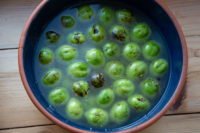 In discussing pickling walnuts Ralph Ayres, head cook at New College in the early 18th Century, recommended that you ‘Gather them when they are a bout the bigness of a pigeons Egge or befor they have any shell….’ So a few days ago Lord and Lady Muck went down with baskets and an improvised hook and harvested three dozen – all about the size of a pigeons egg. Now they are are in their first round of soaking in brine, and in a couple of months or so after a further brine treatment and pickling in jars with vinegar and spices, to my own not-so-secret-recipe (see my Cowley Road Cookbook p 22) they will be ready to eat. Result, a great condiment with cheese or charcuterie; squirrels outwitted!
In discussing pickling walnuts Ralph Ayres, head cook at New College in the early 18th Century, recommended that you ‘Gather them when they are a bout the bigness of a pigeons Egge or befor they have any shell….’ So a few days ago Lord and Lady Muck went down with baskets and an improvised hook and harvested three dozen – all about the size of a pigeons egg. Now they are are in their first round of soaking in brine, and in a couple of months or so after a further brine treatment and pickling in jars with vinegar and spices, to my own not-so-secret-recipe (see my Cowley Road Cookbook p 22) they will be ready to eat. Result, a great condiment with cheese or charcuterie; squirrels outwitted!
June 17, 2020
For the past fifteen years the Divinity Road Area Residents Association (DRARA) Lord Muck’s neighbourhood residents association, has organized an initiative to show off the glories of it local gardens hidden behind those Victorian facades. Indeed this Open Garden event has become a fixture of the social calendar every early summer, and most years Lord Muck has been a participant. There is a bit of a downside to that. Showing off the glories of your own garden and answering the questions of the visiting hordes (well at least a couple of dozen people) means you can never get to see those of your neighbours. And some of the neighbours are very good inventive gardeners. The one that consisted entirely of poisonous or stinging plants was always a highlight – as long as you weren’t accompanied by young children.
This year though everything is different. A combinaton of lockdown and glorous Spring weather (May was the sunniest month ever recorded in Oxford, and less helpfully, the driest May since the 18C with just 3.5 m of rainfall) has enabled people to focus on their gardens. 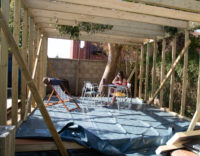 Indeed a fair few neighbours have been doing some major works, ranging from the construction of an extremely impressive ‘man shed’, to the re-turfing of their entire back yard. But of course lockdown and social distancing rules have meant no Open Gardens this year. Or at least not in any physical sense. But it seemed a shame to lose all that hard work and clement weather, so as with so many other aspects of life under lockdown, the gardens took to the virtual world.
Indeed a fair few neighbours have been doing some major works, ranging from the construction of an extremely impressive ‘man shed’, to the re-turfing of their entire back yard. But of course lockdown and social distancing rules have meant no Open Gardens this year. Or at least not in any physical sense. But it seemed a shame to lose all that hard work and clement weather, so as with so many other aspects of life under lockdown, the gardens took to the virtual world. All participants were invited to share up to eight photos with an introduction and commentary on each, to be launched on the designated day – 14 June – as a virtual tour. Here it is and Muck’s garden is featured first, with of course a photo of the compost heap as introductory picture:
All participants were invited to share up to eight photos with an introduction and commentary on each, to be launched on the designated day – 14 June – as a virtual tour. Here it is and Muck’s garden is featured first, with of course a photo of the compost heap as introductory picture:
https://padlet.com/drara/OpenGardens?mc_cid=a6f888cbf1&mc_eid=295d2f0018
What a joy a they are! How diverse are those little patches behind some rather similar Victorian and Edwardian facades; formal, bird friendly, water-based, perspective and view-focussed…. and all the proud owners can see everyboyd else’s garden as well for once.
April 25, 2020
Back in 1996 a band called Summit released an album called ‘Weeding the cliff edge’. Their label call it ‘down tempo/ambient’. One of their fans described the You Tube version as ‘one of the strangest techno albums I’ve ever heard.’ Lady Muck reminded me of this truly obscure musical event – she knew about it because she shared a house with one of the band members back in the day – when we discussed the current lockdown and its impact on us. She was referring to the title, rather than the music itself, as a metaphor for how we feel right now. I had been explaining that my growing season, despite the utterly glorious weather and all the time available, hadn’t been as successful as I’d have hoped and that repeat sowings of beans were going a bit awry. Especially runner beans for some reason. So I’d placed some more in an improvised sprouter to get them on their way. Three days later on checking to see how they were getting on I’d looked at them and thought ‘Those aren’t runner beans. They are broad beans. I’ve got lots of sprouted and planted out broad beans. What am I doing?’ Minor panic. Am I losing my marbles? Not exactly, but perhaps the subconscious is still fixating on the bigger things of life – like will I still be alive in three months time? Will my loved ones be? What about my neighbours? When will all this end? Actually most of the time I’m like everybody else – fretting about the length of ‘socially distanced’ queues at the shops, wondering who is in that ambulance that raced by the house ten minutes ago, but otherwise enjoyng the sun, the time to read, write and think, and missing the closeness and interaction with Lady Muck and daughters. (Actually, lucky me, at 66 I don’t have to worry about if I will have a job to go back to, or where the next meal is coming from, like so many people) But this response is rather like weeding on the cliff edge. It is a perfectly reasonable past time. Until you look over the edge to see what is there over the cliff. Then suddenly you question what the weeding is for.
March 31, 2020
It is too early to tell whether the national lockdown introduced to combat the spread of the Coronavirus – COVID19, will be short-term, long-term, or perhaps an extreme version of the ‘new normal’ where travel and going to work gradually become less a part of our daily lives. But the past two weeks of ‘social distancing’, and more recently the lockdown, has sure made me realise the value of one element of my life. The allotment. I have been on the allotment site since 1988, so I know it well and I know the people on it, by and large, pretty well too. I have always valued it, it has been a lodestar in my way of life for decades, but only now am I coming to appreciate its full value. The past couple of weeks have been difficult for everybody as they adjust to the new ways of living their lives, and having lived in a flat on the fifteenth floor of a ‘hard to let’ tower block in Southwark in the 1970’s, I can empathise with people cooped up in small spaces with little access to fresh air and exercise opportunities. The weather has been both a joy and a frustration. After an unusually long wet, windy and gloomy winter and early spring, the winds have abated and the sun has come out for a glorious spring time. Just the moment to head for the park, the countryside, or the beach. And just the time when the Government doesn’t want us to.
But heading for the allotment is OK. The combination of more time and perfect weather has done wonders to mine, after months of enforced neglect. Being on it has made me reflect on its joys: fresh air and the opportunity to look at the cloudscapes; birdsong which suddenly has a clarity that hasn’t been apparent for decades as the streets fall quiet and no aircraft pass by overhead; 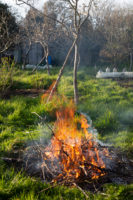 the pleasureable exercise of digging, planting, pruning and bonfire making; the time to dream as plants begin to spring to life, blossom on the plum trees, garlic shoots poking through the soil; and of course company. It is an odd one that. Allotment gardening is a slightly strange mixture of solitude and the social. Most of the time the digging planting, weeding, tending and harvesting are done alone or in the company of a loved one. But seeds, plants and advice are swapped with fellow plotholders, as too are observation on the weather, intelligence on everything from manure deliveries to plot security, and of course the occasinal beer and gossip after a days work. None of this has stopped, but it is done in a much more circumspect manner. Instead a strange (or so it still feels at the moment) separation of interaction has evolved, without a complete abandonment of conviviality
the pleasureable exercise of digging, planting, pruning and bonfire making; the time to dream as plants begin to spring to life, blossom on the plum trees, garlic shoots poking through the soil; and of course company. It is an odd one that. Allotment gardening is a slightly strange mixture of solitude and the social. Most of the time the digging planting, weeding, tending and harvesting are done alone or in the company of a loved one. But seeds, plants and advice are swapped with fellow plotholders, as too are observation on the weather, intelligence on everything from manure deliveries to plot security, and of course the occasinal beer and gossip after a days work. None of this has stopped, but it is done in a much more circumspect manner. Instead a strange (or so it still feels at the moment) separation of interaction has evolved, without a complete abandonment of conviviality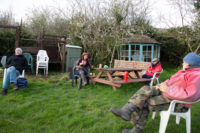 . The conversations are held at a distance – often a plot width, and gathering round a table with beer and nibbles is no longer possible – instead a version ‘alone together’, allowing a sense of community without the contact, is emerging. The combination of solitude, nature, exercise, and (some) company is likely to be one that keeps a lot of people on the right side of sanity in the next few months. Allotments have always been places to cherish. Even more so now.
. The conversations are held at a distance – often a plot width, and gathering round a table with beer and nibbles is no longer possible – instead a version ‘alone together’, allowing a sense of community without the contact, is emerging. The combination of solitude, nature, exercise, and (some) company is likely to be one that keeps a lot of people on the right side of sanity in the next few months. Allotments have always been places to cherish. Even more so now.
February 28, 2020
Lady Muck drew my attention to a label on the milk she buys from Waitrose that trumpets that all their mik comes from cows who are pasture-grazed for at least 120 day a year. Great stuff. Except that there are 365 days in a year (except this year of course!) so what do the cows get up to on the other 240-odd days? 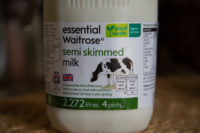 The fantasist in me wonders if they are grazing indoors – perhaps at one of those hotel buffets now deserted by humans because of the Covid-19 lock down in said hotel. But that is rather far-fetched, if a charming idea. It is surely not cheaper to feed cows indoors for two thirds of the year, although grass, even in these times of global climate breakdown doesnt grow year round, so it is inevitable that the beasts will need at least supplementary feed – hay or silage anyone – for some part of the year. But eight months? This isn’t Iceland. The climate there means that cows do indeed get stabled indoors for about eight months a year, and come mid-May, when they are let out, it is more or less a day of national celebration, and not just for the cows. Schools cancel lessons for the day to allow children to go to farms to watch the cow’s first steps of the year on grass, with fresh air and sunshine to savour. Unsurprisingly the cows are more than delighted, and come racing out dancing and skipping as only cows can. A sight to delight any nine year old – or adult. Perhaps Waitrose think its all worthwhile for British cows too to be kept indoors for so long. But in that case where are the coach loads of excited school children there to watch their first steps out of captivity?
The fantasist in me wonders if they are grazing indoors – perhaps at one of those hotel buffets now deserted by humans because of the Covid-19 lock down in said hotel. But that is rather far-fetched, if a charming idea. It is surely not cheaper to feed cows indoors for two thirds of the year, although grass, even in these times of global climate breakdown doesnt grow year round, so it is inevitable that the beasts will need at least supplementary feed – hay or silage anyone – for some part of the year. But eight months? This isn’t Iceland. The climate there means that cows do indeed get stabled indoors for about eight months a year, and come mid-May, when they are let out, it is more or less a day of national celebration, and not just for the cows. Schools cancel lessons for the day to allow children to go to farms to watch the cow’s first steps of the year on grass, with fresh air and sunshine to savour. Unsurprisingly the cows are more than delighted, and come racing out dancing and skipping as only cows can. A sight to delight any nine year old – or adult. Perhaps Waitrose think its all worthwhile for British cows too to be kept indoors for so long. But in that case where are the coach loads of excited school children there to watch their first steps out of captivity?
November 19, 2019
Oxford’s Ashmolean Museum is hosting an exhibition ‘Last supper in Pompeii’ which celebrates the Roman love affair with food and drink focussing on the artefacts recovered from that devastated city. Lord and Lady Muck visited the ruins last year.  Even is mid-September it was hot, and the sheer scale of it at times intimidating. Looking at the archeological discoveries, whether in the wonderful National Archeological Museum in Naples, or in the Ashmolean exhibition is a little more … digestible. Naturally the museum’s focus on what has been recovered from under the volcanic ash, and the amazing things it has preserved. Food and drink are important but it has taken the Ashmolean exhibition to foreground them. What has survived casts a fascinating light on the lives of Romans in what was a pretty ordinary town in Italy. Pompeii was unique only in the sense that it was on the slopes of Mount Vesuvius and came to grief because Vesuvius was an active volcano. So the culinary culture of Pompeii while different from that to be found in the Britannia of the time was different mainly because of climate rather than culture. Fish and chips were served neither in Britannia nor Pompeii; no such thing as the potato in the Roman Empire of course.
Even is mid-September it was hot, and the sheer scale of it at times intimidating. Looking at the archeological discoveries, whether in the wonderful National Archeological Museum in Naples, or in the Ashmolean exhibition is a little more … digestible. Naturally the museum’s focus on what has been recovered from under the volcanic ash, and the amazing things it has preserved. Food and drink are important but it has taken the Ashmolean exhibition to foreground them. What has survived casts a fascinating light on the lives of Romans in what was a pretty ordinary town in Italy. Pompeii was unique only in the sense that it was on the slopes of Mount Vesuvius and came to grief because Vesuvius was an active volcano. So the culinary culture of Pompeii while different from that to be found in the Britannia of the time was different mainly because of climate rather than culture. Fish and chips were served neither in Britannia nor Pompeii; no such thing as the potato in the Roman Empire of course.
The exhibition takes us on a tour of the fields, vineyards, orchards and seas around Pompeii including one of the more remarkable discoveries, the well preserved ‘footprint’ of a Roman vineyard just outside Pompeii. The Pompeian street is well represented, and this is where a visit to the place itself really brings the whole experience alive – the hustle and bustle of shops and bars – the bars in particular, which did also provide food, mainly for the less well off.  Food was more than just for eating. The gods needed feeding as well; perhaps they didn’t like the fare on offer just before Vesuvius erupted, and the buried remains of burnt offerings on display are there to remind us of the vital role of food and drink in the religion of the time. It is interesting to speculate on how the gods are feeling these days.
Food was more than just for eating. The gods needed feeding as well; perhaps they didn’t like the fare on offer just before Vesuvius erupted, and the buried remains of burnt offerings on display are there to remind us of the vital role of food and drink in the religion of the time. It is interesting to speculate on how the gods are feeling these days.
Roman agricultural practices and cuisine were naturally adopted in Britannia once it became part of the empire, but to keep up the exotic variety, plenty of food stuffs were imported for man and god alike; sacred pine cones (and their nuts) from the Mediterranean, tunny fish from north Africa, olives and wine by the barrel from southern France, dates from Lebanon and pepper from India; luxuries that all made their way to Roman Blighty two thousand years before we think of these things as normal fare for the middle class household. And the dormouse was something of a delicacy in Britannia too, fattened up in a special cage. But not currently available at the Waitrose deli counter.
But not currently available at the Waitrose deli counter.
It is fun to speculate on what the civilised inhabitants in the northern parts of the Roman Empire ate on a daily basis, and the Belgian cookery writer Brigitte Lepretre has made an attempt in her book ‘Ancient Roman cuisine’. As she warns us in her introduction, ‘it has proved necessary to use a little imagination to decide what a Roman dish could be like.’ She has re-worked a series of recipes written by Marcus Gavius Apicius, who was cook to Emperor Tiberius in the first century AD – around the time of the destruction of Pompeii. Cook maybe, but a man of substance, wealthy with an inordinate taste for good food, even travelling to Libya in a ship chartered specially for the purpose, to procure shrimps that had been praised to him. He didn’t rate them apparently. But his recipes survive, though Lepretre describes them as ‘hardly usable as they are: very often no quantities are given and cooking methods and times are not specified.’ Of course the very products used two thousand years ago, vegetable marrows, fruit, spices etc (quite apart from the dormice) were probably rather different from what we know today. But the dishes are both appetising and exotic; green asparagus and ricotta patina, roasted mullet with fava beans, roast pork in pine nut sauce, braised guinea fowl with figs, lentils and chestnuts, and to finish up fresh curds with honey and fruits. Last Supper in Pompeii maybe a treat but sadly the ticket price didn’t seem to come with a tasting menu.
Last Supper in Pompeii is at the Ashmolean Museum, Oxford until 12 January 2020
October 11, 2019
I recently bought a block of ‘organic’, ‘smoked’ tofu from a long-established local wholefood shop. Nothing terribly newsworthy there. But looking at the packaging, where I saw it had been ‘naturally smoked over beech wood chippings’ in their smoking kiln, I was amused to see that it also described itself as ‘locally produced’. How local? I thought. A quick scan of the packaging revealed that its manufacture was on an industrial estate in ….. North Yorkshire. I suppose if I’d bought it in Yorkshire or Cleveland (or whatever that little-lamented county is now called) the claim to localness would have stood up. But its manufacturer Clearspot, distributes nationally, so it can only be local some of the time. But ‘local’ these days means ‘authentic’ ‘trusted’, ‘small scale’, and not made on an industrial estate … unless it is. Its a selling point though. And it seems quite a powerful one in this world of local foods and the artisan small-batch production.
But ‘local’ these days means ‘authentic’ ‘trusted’, ‘small scale’, and not made on an industrial estate … unless it is. Its a selling point though. And it seems quite a powerful one in this world of local foods and the artisan small-batch production.
It is a while ago when those directories of local foods first started being produced by the environment departments of local authorities. I well recall an amusing story told by the council officer in Gloucestershire responsible for the production their local food guide, of the huge fuss made by Walls Ice Cream that they weren’t included. After all their factory was just outside Gloucester and they were a food producer – ergo they were a local producer, just like the organic farm down the road and should be included in the directory. Impeccable logic, but they didn’t make it, and I doubt that the omission made much of a dent on their sales. But of course they failed a different unstated, test – authenticity.
This confusion isn’t confined to producers. When I worked for Warwickshire county council a decade ago I used to stay quite regularly in a B&B in the town run by a charming young couple. They too understood the importance of local sourcing for their customers breakfasts. The menu carefully explained where their eggs, sausages, mushrooms, tomatoes etc all came from. Locally sourced of course: sausages and bacon from the butchers in town (so far so good), eggs tomatoes and bread from the Sainsbury’s supermarket down the road, and milk from the local garage forecourt shop. All local. What not to like? But probably not what was meant by the term ‘local food’, though there was also a chance that some of the supplies were ‘local’ in the other sense of the word.
So local is one of those ambiguous words freighted with a meaning somewhat heavier than the load it is designed to carry. But it sure isn’t the only one. One of my abiding memories, as a hen-keeper of my one and only visit to Australia over 15 years ago, was being assailed by shops selling ‘gluten-free eggs’. Hey, who knew that most (wicked) eggs had gluten in them? I still refer to Australia, when the subject comes up as ‘the home of the gluten-free egg’. But then, somewhat less controversially I accept, for years Tesco used to promote the joys of its own-brand apple juice as a drink to be consumed ‘lovely and cool’. As opposed to all those horrid juices you could buy in Other Supermarkets, that were warm and nasty? Why on god’s (organic, local, and beech-chip smoked) earth, would anyone buy one of those?
September 1, 2019
It is officially the first day of autumn, so time to report on progress in the front garden since its refurbishment in the Spring. It has certainly turned heads all summer. Any time Lord Muck is mucking about in it, someone walks by and comments. Mainly in a complementary fashion. At first it was about the planting and the brickwork – very fine I agree. But as the summer progressed the lettuces, now harvested or in a few cases gone to seed, were the object of much comment, and latterly it has been the extremely prolific tomatoes. 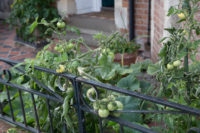 What a year for tomatoes it has been. Not only have they thrived, but have produced so early too. I have already cut down the vines in my allotment poly tunnel, having harvested kilos and kilos of them. The ones in the front garden aren’t so far advanced, but the first pick has happened. One couple, long-term residents on the street, wondered if as they ripened they wouldn’t get stolen. As far as I can tell none have so far, perhaps the neighbourhood is ‘on the up’. Maybe that will change, but I can afford to be generous this year and in any case if the occasional one goes, that person’s need is probably greater than mine. To be honest while picking one off the vine guarantees freshness, I have taken to placing a wooden box by the gate filled with courgettes, apples and tomatoes for passers by to help themselves to anyway.
What a year for tomatoes it has been. Not only have they thrived, but have produced so early too. I have already cut down the vines in my allotment poly tunnel, having harvested kilos and kilos of them. The ones in the front garden aren’t so far advanced, but the first pick has happened. One couple, long-term residents on the street, wondered if as they ripened they wouldn’t get stolen. As far as I can tell none have so far, perhaps the neighbourhood is ‘on the up’. Maybe that will change, but I can afford to be generous this year and in any case if the occasional one goes, that person’s need is probably greater than mine. To be honest while picking one off the vine guarantees freshness, I have taken to placing a wooden box by the gate filled with courgettes, apples and tomatoes for passers by to help themselves to anyway.
Pride and joy have been the padron peppers. 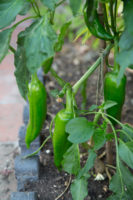 Just look at the growth on those. Grown from seed. Honest. And the butternut squash promise to run riot during the autumn. Brick work? What brickwork?
Just look at the growth on those. Grown from seed. Honest. And the butternut squash promise to run riot during the autumn. Brick work? What brickwork?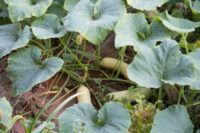
And how about the perennials? They all seem to be flourishing. It has been hot, so plenty of water has had to applied, especially to the Daphne, as designer Kate from Oxford Garden Partners never fails to remind me when she passes by, but the Rock Rose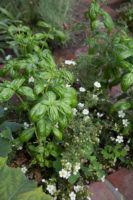 and Hydrangea in particular have been spectacular. One development that has probably helped: a swarm of bumble bees has taken up residence in the shed that leads of from the front garden. AirBnB takes on a whole new meaning.
and Hydrangea in particular have been spectacular. One development that has probably helped: a swarm of bumble bees has taken up residence in the shed that leads of from the front garden. AirBnB takes on a whole new meaning.
It is often said that front gardens and front doors are a microcosm of the character of the house within; symbolic, a portal into another world – especially from a child’s point of view. The front door is a dark green; now the garden amplifies that sense of a green portal.
 Almost one third of the 100,00 population of the Skibbereen area lost their lives during those terrible years, with many more forced to emigrate, and the town became synonymous with the suffering of people across Ireland after it was widely publicised in the famous stark drawings of James Mahoney for the Illustrated London News.
Almost one third of the 100,00 population of the Skibbereen area lost their lives during those terrible years, with many more forced to emigrate, and the town became synonymous with the suffering of people across Ireland after it was widely publicised in the famous stark drawings of James Mahoney for the Illustrated London News.  The cause of the famine in the first place was an over-reliance on a single variety of potato by an extraordinarily impoverished populace. When it got blight and the potatoes rotted in the ground there was nothing to fall back on, and the British state was completely unprepared for, and then unwilling to act to relieve, a famine in its own country (Ireland was then part of Great Britain and Ireland, post the 1801 Act of Union).
The cause of the famine in the first place was an over-reliance on a single variety of potato by an extraordinarily impoverished populace. When it got blight and the potatoes rotted in the ground there was nothing to fall back on, and the British state was completely unprepared for, and then unwilling to act to relieve, a famine in its own country (Ireland was then part of Great Britain and Ireland, post the 1801 Act of Union). and then planted them in a field in a very isolated valley out beyond Castlehaven. News got out of this illegal stash, and he was instructed to reveal the location of the field where these potatoes were. But by that time they were up and thriving, never caught the blight, and went on to produce an excellent crop; a crop which saw the family through the famine.
and then planted them in a field in a very isolated valley out beyond Castlehaven. News got out of this illegal stash, and he was instructed to reveal the location of the field where these potatoes were. But by that time they were up and thriving, never caught the blight, and went on to produce an excellent crop; a crop which saw the family through the famine. But it is a reminder of the narrow path we tread between feast and famine, one which in this year of an excellent harvest, is all the more powerful for being at a time of global sadness and death from another invisible airborne grim reaper.
But it is a reminder of the narrow path we tread between feast and famine, one which in this year of an excellent harvest, is all the more powerful for being at a time of global sadness and death from another invisible airborne grim reaper.















